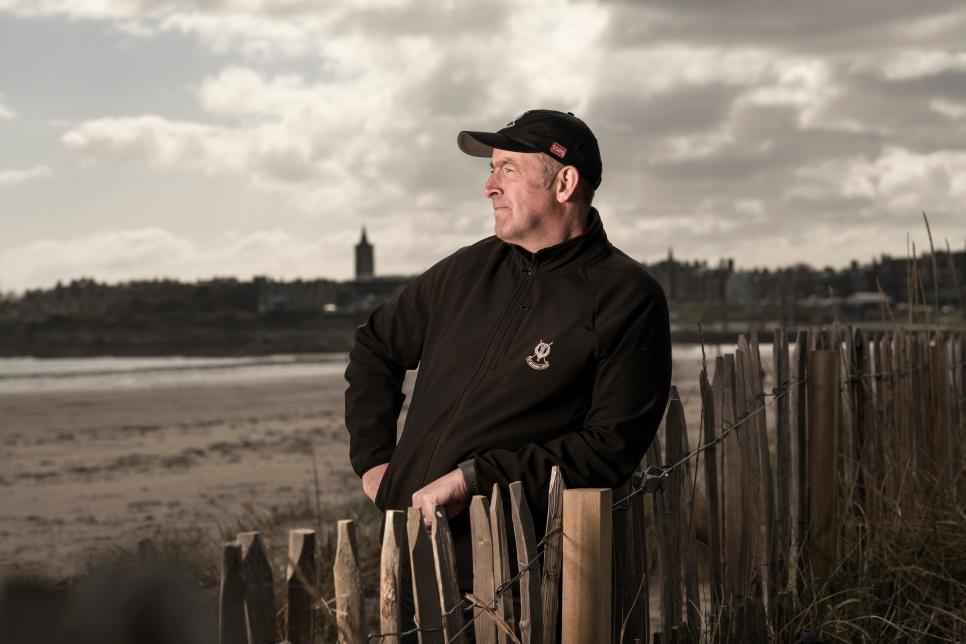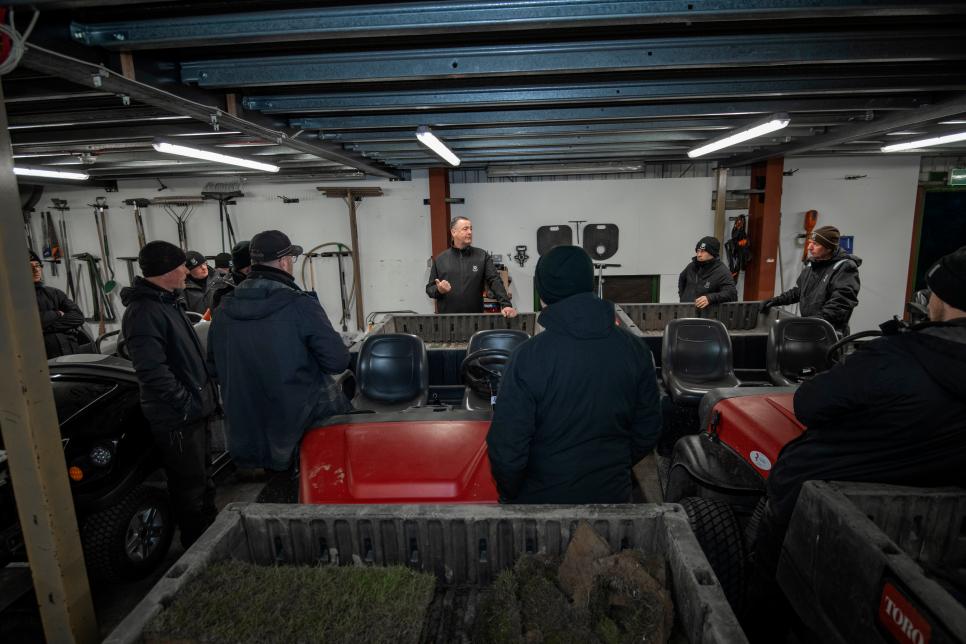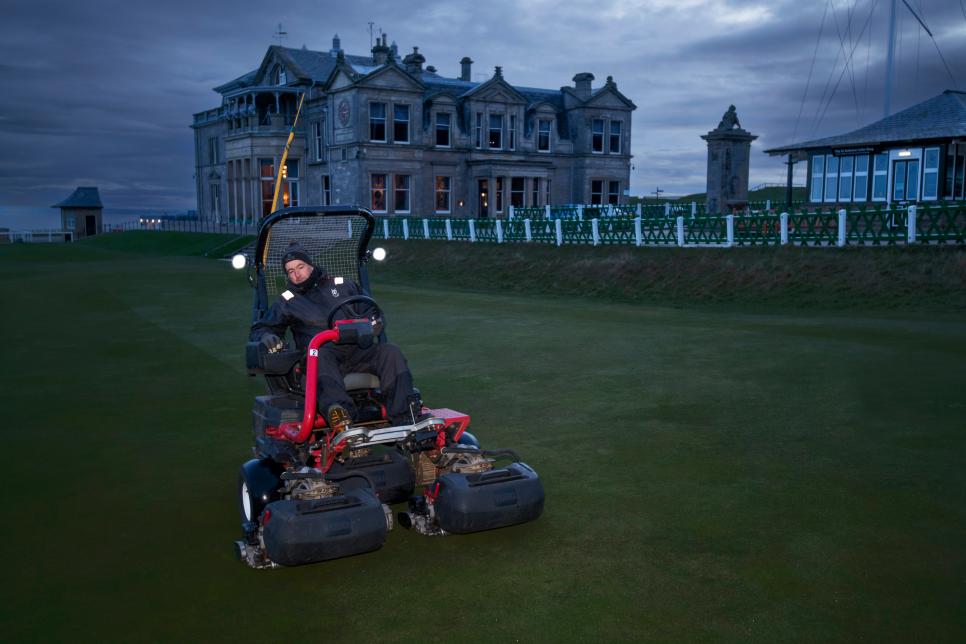'A Constant Effort'
The Protector of the Old Course: Why the tenure of St. Andrews' ninth superintendent could be the most critical

It was an unusually cold Sunday morning in March when I made the trip to St. Andrews, Scotland, in search of Gordon McKie, the head greenkeeper of the Old Course and just the ninth person to have that title since Old Tom Morris. Passing the Royal and Ancient clubhouse and across the practice range, I found the greenkeepers building (shed wouldn’t do it justice). I asked one of the men if Gordon was about.
“Gordon? He’s far tae important to be here on a Sunday!”
I was both disappointed and happy: Disappointed it was a wasted journey but happy that, by the sound of it, I was in search of the right man.
I went for a walk around the Old Course, circumnavigating the layout by the path that covers its outer edges. Despite some gray weather, I pushed on, and when I reached the farthest point of the neuk, I found a lone greenkeeper tending to the championship tee on the short par-3 eighth hole. He was filling divots by hand.
As I got closer, I thought he looked similar to the man I was looking for. With just enough service on my cellphone to Google “Gordon McKie,” I pulled up a photo of him and matched it against the man on the tee.
It was indeed my man. The head of the greenkeeping staff at the Old Course, without even his team knowing it, was out on a Sunday tending to his links. I arranged to meet him a few days later at a time that fit his schedule and began prepping my questions on the topic of protecting the Old Course for the challenge of the 150th Open Championship and the legacy of the role that he now holds.
McKie is tall, well built with short hair and almost always dressed for the elements. He arrived at the Links Clubhouse, right of the second hole on the Old Course, suitably dressed for a cold, windy day in St. Andrews. We sat down for a coffee and immediately got into his position at the St. Andrews Links, the organization that manages and maintains all seven courses in St. Andrews, the largest public golf complex in Europe.
“There’s no better job,” he says, with a not-so-subtle grin on his face. “It’s a huge honor, not just for me but for my family, to be the ninth head greenkeeper at the Old Course since Old Tom. I chat to a lot of people in my profession from around the world, and they are envious of what I, and my team, get to do. I don’t think there’s a prouder person on the planet than myself, being able to wake up each day and look over this land and after the golf course here.”

ANCIENT LAND: The Old Course’s fourth green and the town of St. Andrews.
Dom Furore
McKie came to St. Andrews from Tain Golf Club in 1996 and worked his way from deputy head greenkeeper at the Eden Course to his position now overseeing the work on the Old Course. He laughed when I asked at what stage does the planning for an Open Championship begin. “It never starts, and it never ends. The first Open was here in the 1870s, and every greenkeeper team since then has been preparing for the next Open.”
Back then, the team at St. Andrews was run by Old Tom Morris. He and his son had won eight of the 12 Open Championships that had been played, and in his role as “Keeper of the Green,” he prepared the course for the first Old Course Open in 1873.
Fast forward nearly 150 years, and McKie and his team are tasked with protecting the links and getting it ready to host the Open for the 30th time.
“We do today the same things that Old Tom would have done back then; we just do it in a modern way,” McKie says proudly. “We’re a maintenance team, not renovators. We are here to maintain the history of what this place is and try not to change it.”
“There’s not a lot we can do here to lengthen the course, so the tweaks tend to be more strategic in terms of fairway widths, angles and sometimes even shortening holes or lines to bring more of the challenge.”
An example is 16th hole. Named “The Corner of the Dyke,” it’s a par 4 that bends from left to right, guarded on the inside by a tight out-of-bounds line and on the left side of the bend by the Principal’s Nose bunkers, two scorecard-wrecking pot bunkers that dominate your eyes from the tee.
“Do we think about moving the tee up there on 16?” McKie asks. The distance to carry the bunkers from the standard championship tee is about 270 yards. “It would allow everyone in the field to take that bunker out of play if they wanted to, but they would need to cut the corner more, bringing out-of-bounds into play. Now the left miss doesn’t find the third fairway; it finds the rough closer to the green, which, considering where the bunkers are positioned around the green, would leave a pretty miserable shot in.”
McKie reminisced fondly about the Women’s Open Championship, played for the first time on the Old Course in 2007. The women that week played from the original championship tees laid out by Old Tom in 1873.
“The women played from 6,600 yards, and it was amazing to watch. Every hazard was in play. There were a lot of questions they had to answer with each shot. The course was being played as it was designed to be played.”
Lorena Ochoa won her first major championship that week, winning by four strokes with a score of five under par. It’s worth noting that each of the last four men’s Opens played at the Old Course were won with scores of 14 under par or lower.
‘I DON’T THINK THERE’S A PROUDER PERSON ON THE PLANET THAN MYSELF, BEING ABLE TO WAKE UP EACH DAY AND LOOK OVER THIS LAND AND LOOK AFTER THE GOLF COURSE HERE.’
So how can the Old Course present a challenge to the men in 2022?
McKie believes the strategy, specifically around the bunkers, is the key.
“There are 112 bunkers out here, and each of them can hurt your round,” he says. “It’s not about adding more or moving the ones we have; it’s about small things you can do to put them more into play and get the players thinking about them on every shot.”
In fact, the sand in those bunkers might feel different to players at the Open this year compared to previous years. McKie explained to me that he is working with Grant Moir and Richard Windows from the R&A’s rules and agronomy teams, respectively, and that there will be less sand in the Old Course bunkers this year. That small change will give the bunkers a “tougher feel and depth” and perhaps make them even less appealing to flirt with.

HANDLE WITH CARE: McKie shows the 17th hole’s Road Hole bunker to superintendents from Sweden and Norway.
Dom Furore
“The other thing here at the Old Course is, it’s old,” McKie says. “If you want to change or remove a bunker, you’ve got to worry about finding out who it’s named for and making sure the family won’t be upset if you move it!”
Take for example “Cheape’s bunker” on the left side of the par-4 second hole. It is named after Sir James Cheape, who bought the golf course from rabbit farmers back in the 1820s. The land was then sold to the R&A, which helped develop it into what it is now. Imagine having to call Sir James’ family and explain to them that you were removing the bunker to create a more challenging angle for the likes of Scottie Scheffler. I’m not sure they would approve.
As for Old Tom’s family, his great, great granddaughter, Sheila Walker, still lives in the family residence above her great, great grandfather’s old shop on the corner by the 18th green of the Old Course. A typically private person, Walker opened her door to McKie and a select few members of the St. Andrews Links last June to celebrate Old Tom’s 200th birthday. A cake was delivered to the house, and she and McKie enjoyed a piece while chatting and glancing out across the 18th fairway.

RIPPLES IN TIME: Low light shows off the dips and bumps of the par-4 second.
“I spent about 45 minutes there with her, just chatting about Old Tom and looking at old photos and notes that she had. The place is like a museum to the man. It was inspiring to see him at work and how hands-on he was. It’s something I’ve tried to make a part of what I do, always being visible and being on the front line to help out and explain what we’re doing.”
McKie, originally from Glasgow in West Scotland, did have a deep knowledge of Old Tom’s life and craft dating back to his time before St. Andrews. He attended Scotland’s Rural College in Elmwood and studied Old Tom and his influence on greenkeeping and techniques he developed across the links at the Old Course.
“When I first came to work here in 1996, I read up on Old Tom and any books I could get my hands on. I just wanted a feel of the course more so than the man, but I definitely got a feel for what his approach was and how key his decisions were in what we still do today.”
If McKie took inspiration from Old Tom originally, that influence was magnified by the COVID-19 pandemic in 2020. The grounds crew at the Old Course was trimmed from 14 full-time greenkeepers to four, including McKie. The course was closed for three months, and the team began to see an entirely new piece of land and way of maintaining it. “We soon learned that less is more,” McKie says.
“There was no way we could look after the course like we did before, so we had to rethink priorities and leave parts of the course we would normally tend to, like bunkers and rough. What we saw was pretty amazing.”
It’s worth remembering that although the Old Course is a tightly packed property, the green complexes alone represent nearly 300,000 square feet that needed to be tended to. With a staff of only four running things, McKie and his team had to be selective in how they looked after the land.

GREEN PRACTICES: McKie and his staff have cut back on water, fertilizer and fuel.
Dom Furore
“Usually there are 40 to 50 thousand rounds played on the Old Course each year,” he says. “During the pandemic, there was no golf played for 12 weeks. There was very little foot traffic on the course, no trolleys, no buggies, no caddies. We saw this amazing growth in the rough. Instead of being matted down and formed by how people would walk across it, the grass began growing thicker and vertically.”
That kind of growth and rough is not something you would normally see at the Old Course. However, it might be something you see in July.
“Now that play is back,” McKie says, “we’ve roped off large areas of rough from golfers throughout the course to prevent that foot traffic and to take what we learned during lockdown and apply it to our preparation for the Open. We haven’t done that before.”
I asked McKie if that change in approach would affect the difficulty of the course and how it might be played by the best players in the world.
He smiled. “Obviously 17 is the ultimate risk-and-reward test, right? If you take the tight line, over the hotel, you will be rewarded,” McKie says. “If you go middle or left, it’s more difficult. In previous Opens that rough on the left has been wispy and almost non-existent, and players get it up around the green. This year that may be a different challenge.
“I remember having a chat with Ian Poulter about how hard the 17th hole played back in 2010,” McKie says. “He was remembering when the hole played into the wind, and players were choosing to hit down the second fairway and leave themselves a 220-yard shot in. My response was simple: That’s your choice. The bold choice is to take on the hotel, take on the right side of the fairway and get the reward. That’s how the hole was designed, and there’s definitely a sense of pride in keeping that challenge in play.”
McKie and his team are also proud of their efforts to make their work sustainable and green. “We consider ourselves industry leaders,” he says.

A LITTLE OFF THE TOP: McKie cuts the 18th green with his Toro electric mower.
Dom Furore
In 2015, he employed a staff of 75 to look after the course during the Open, but this year it will be just 50. The team is also cutting back on water use, fertilizer and fuel usage. As the story goes, a single greenkeeper double-cutting the fifth/13th green at the Old Course would have to walk up to nine miles. That takes a while. However, in 2022, that is no longer the case. “We now have battery-powered mowers that double cut in one go. Those mowers are then charged by solar power, and the water that goes on the greens is bored from the ground beneath the course or from rainwater that is recycled in a storage tank by the greenkeepers shed.”
The 150th Open this July will run independent of gasoline: Solar panels and bio-fuel generators will supply the power for everything on the grounds.
In terms of being more green, it doesn’t get much greener than using Christmas trees to protect the Old Course. (Stay with me here.) In the weeks after Christmas each year, McKie and his team take delivery of Christmas trees from people within the town of St. Andrews. They are delivered to the East Sands car park by the greenkeepers building, and they are then cut down and buried into the sand dunes that surround the Old Course and other courses in the immediate area. Over time they will congeal and help establish a stronger foundation within the dunes to combat coastal erosion.
The Old Course, along with many notable courses in the area, is certainly in a battle against nature when it comes to coastlines. Techniques like these certainly help, but McKie admits that it’s an ongoing challenge. “There’s no getting away from it,” he says. “If you look at the piece of land that the Old Course and other courses sit on here, it’s easy to see why. We’re surrounded by beaches and dunes, and a bad storm can take a chunk out of the coastline overnight. It’s a constant effort.”
Interestingly, members of the greenkeeping team at the Old Course, along with the other St. Andrews Links courses, actually manage and maintain the East Sands, the stretch of beach that borders the golf courses. They work with the local council to improve the quality of the beach and sand dunes and assist in the fight against erosion. “It’s just something we want to do. We see how the world is going.”
I left my time with McKie thinking about exactly that. Time may have moved on, decades may have passed, but the Old Course and the way in which it is maintained have stayed largely, and proudly, the same.
Before leaving McKie to head back to his day job, I posed one last question: If Old Tom were sitting with us right now, maybe sipping on a coffee with a splash of whisky, what do you think he would think of the Old Course in 2022?
“I think he’d be proud of the team and proud of the course. I hope he’d see the course he helped create being maintained in the way he did. I’d like to think he’d give me a modest pat on the back and be happy with the job we’re doing.”
I’d tend to agree.




